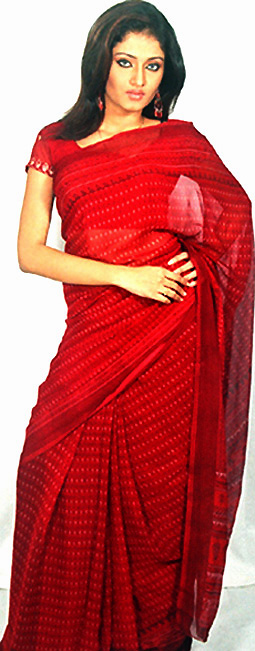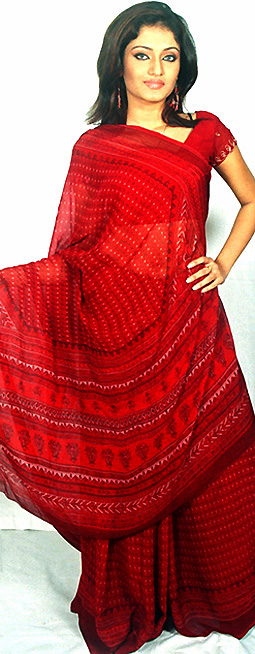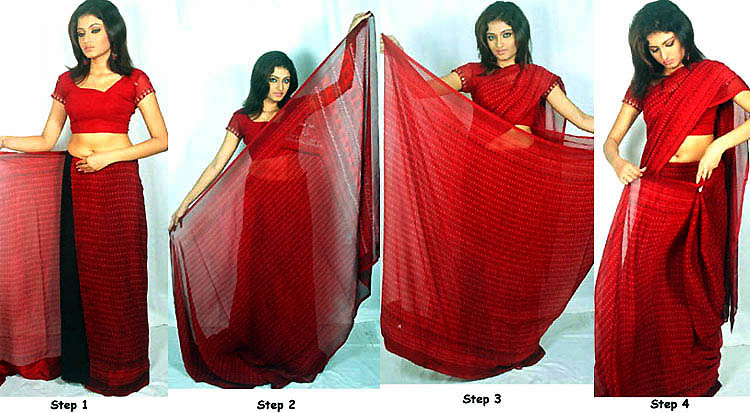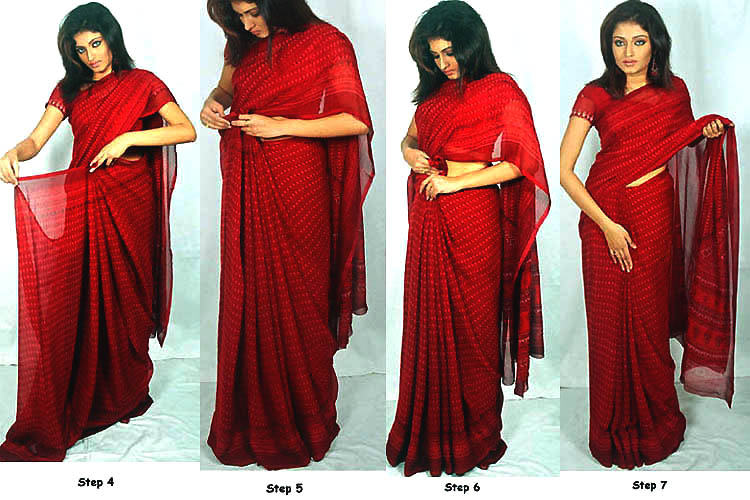
Contemporary Style This is the most commonly favored style and is easy to manage with the help of a pin. It is the more commonly used style for formal work-related occassions as it looks crisp neat and smart. The Pallu is flung over the left shoulder. It can either be left to drape over your entire left arm or be gathered in pleats onto the shoulder. A pin can be used to secure the saree to your shoulder but we caution you to be careful as this can damage delicate sarees. |

Gujarati Style This is a traditional draping style from the state of Gujarat. It is easier to manage and suited for draping Heavily Worked / Bridal / Silk Sarees. After tucking the pleats into your Petticoat (Step 6) remove the Pallu section from your left shoulder (over which it had been flung earlier to keep out of the way in Step 3). Bring part of the Pallu forward from your back by draping it over your right shoulder. The Pallu can now be arranged into an upside-down fan-shape from your right shoulder. The remainder is left to hang behind in a J-shaped arc from the back of your left hip where it is still tucked into the waistband, to the back of your right shoulder. |
Different Ways to Drape a Sari Before you Start Two essential parts of attire, that go along with the Saree, need to be chosen carefully to compliment the Saree. These are: A petticoat which is a waist-to-floor garment, tied tightly at the waist by a drawstring. The petticoat color should match the base sari color as closely as possible. No part of the petticoat, of course, is visible outside the Saree, after having worn it. A blouse which needs to be tight-fitting and whose color needs to be chosen keeping the look of the saree in mind, can be short sleeved or sleeveless, with a variety of necklines. The blouse ends just below the bust. Wearing a Sari the Traditional Way * Step 1. Around your body. Starting at the navel, tuck the plain end of the saree into the petticoat and continue tucking till you take a complete turn from right to left. Adjust the lower end of the saree to the height required. Ideally wear your footwear so that you drap...


Hello !
ReplyDeleteThanks for a great blog. . The guidelines are so beneficial.
Thanks for all the information regarding karate mats
For more info about Wedding sarees :
Wedding sarees
Kurtis Online
Bollywood Lehengas
yurtdışı kargo
ReplyDeleteresimli magnet
instagram takipçi satın al
yurtdışı kargo
sms onay
dijital kartvizit
dijital kartvizit
https://nobetci-eczane.org/
PW86E
Muğla
ReplyDeleteSamsun
Eskişehir
Sakarya
Kars
E0RZ
bitlis
ReplyDeleteurfa
mardin
tokat
çorum
YX13C
https://titandijital.com.tr/
ReplyDeletebalıkesir parça eşya taşıma
eskişehir parça eşya taşıma
ardahan parça eşya taşıma
muş parça eşya taşıma
XS7
ankara parça eşya taşıma
ReplyDeletetakipçi satın al
antalya rent a car
antalya rent a car
ankara parça eşya taşıma
RWK2İ7
bartın evden eve nakliyat
ReplyDeleteedirne evden eve nakliyat
mersin evden eve nakliyat
sinop evden eve nakliyat
siirt evden eve nakliyat
X7DUF
maraş evden eve nakliyat
ReplyDeletemaraş evden eve nakliyat
izmir evden eve nakliyat
konya evden eve nakliyat
erzurum evden eve nakliyat
O6V4Y
95877
ReplyDeleteAnkara Evden Eve Nakliyat
Uşak Şehir İçi Nakliyat
Hakkari Lojistik
Iğdır Şehirler Arası Nakliyat
Çerkezköy Çatı Ustası
Sivas Parça Eşya Taşıma
Kripto Para Borsaları
Huobi Güvenilir mi
Amasya Evden Eve Nakliyat
F51BB
ReplyDeleteNiğde Şehir İçi Nakliyat
Aydın Parça Eşya Taşıma
Düzce Lojistik
Tekirdağ Parke Ustası
Çerkezköy Fayans Ustası
Etlik Parke Ustası
Zonguldak Parça Eşya Taşıma
Kripto Para Nedir
Sakarya Evden Eve Nakliyat
303AE
ReplyDeleteKütahya Evden Eve Nakliyat
Paribu Güvenilir mi
Eskişehir Evden Eve Nakliyat
testosterone propionat
Kocaeli Evden Eve Nakliyat
Bayburt Evden Eve Nakliyat
Tekirdağ Evden Eve Nakliyat
Silivri Duşa Kabin Tamiri
Erzurum Evden Eve Nakliyat
B6A16
ReplyDeletetrust wallet web
ledger
bitbox
arculus
trezor suite
ellipal wallet web
eigenlayer wallet
web ledger wallet
wallet ledger live
9259F
ReplyDeleteshapeshift
debank
defillama
avalaunch
DefiLlama
pancakeswap
dappradar
thorchain
layerzero
This comment has been removed by the author.
ReplyDeleteThe blog beautifully outlines the basic steps of saree draping, essential for any saree aficionado. However, it would be enriching to see a mention of draping techniques specific to exquisite Kanchipuram Pure Silk Sarees. These sarees, with their rich heritage and intricate weaving, deserve a spotlight in discussions about saree wearing. Integrating insights into draping methods tailored to these luxurious sarees could enhance the blog's value, catering to readers seeking guidance on styling these timeless classics. Overall, it's a helpful resource for saree enthusiasts seeking to master the art of draping.
ReplyDeleteDiscover the artistry of draping Kanchipuram Silk Sarees with this insightful guide! From the intricate pleats to the graceful pallu, the blog beautifully elucidates the basic steps of saree wearing. Whether you're a novice or an aficionado, this resource offers valuable tips for achieving that perfect drape. Dive into the world of elegance and tradition with Kanchipuram Silk Sarees, and let this guide be your companion in mastering the timeless art of saree draping. Explore the blog now to unlock the secrets of flawless saree styling!
ReplyDeleteHJKUJHKY,IL
ReplyDeleteشركة تسليك مجاري بالجبيل
piukuykiuku
ReplyDeleteشركة عزل اسطح بالقطيف
شركة عزل اسطح بالاحساء eUtemegxED
ReplyDeleteشركة مكافحة حشرات بالهفوف NWJh1dPeFA
ReplyDelete90E32DAB14
ReplyDeletemoonbeam
kavaswap
bitget
dogwifhat
hamster kombat
galxe
puffer
aethir
rocketpool
شركة عزل اسطح بالقطيف XneCZbrk30
ReplyDelete